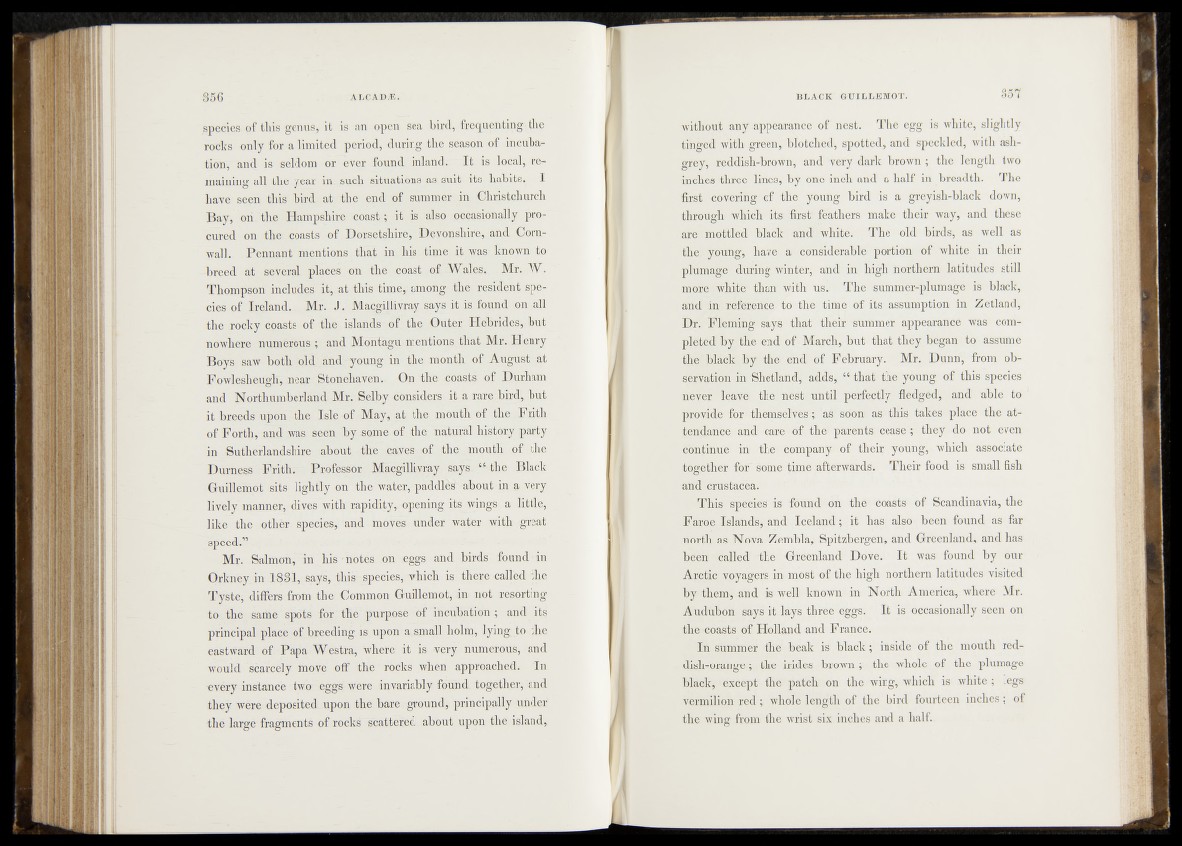
species of this genus, it is an open sea bird, frequenting; the
rocks only for a limited period, during the season of -incubation,
and is seldom or ever found-inlands- It is local, remaining
all the year in such situations as suit its habits* I
have seen this bird at the end of summer in Christchurch
Bay, on the Hampshire coast; it is also occasionally procured
on the. coasts of Dorsetshire, Devonshire, and Cornwall.
Pennant mentions that in his time it was- known to
breed at several places on the coast of Wales, Mr. W .
Thompson includes it, at tlijS- time, among thef, resident species
of Ireland- Mr. J . Macgillivray says‘.it is found on all
the rocky coasts of the islands of the Outer H chri^efr-hnt
nowhere numerous ; and Montagu.mentions, that Mr. Henry
Boys saw both old . andryoung in the montJiv of August at
Fowlesheugh, near Stonehaven* On the coasts- of Durham
and Northumberland Mr. Selby considers it a rare bird, but
it breeds upori7 the Isle of -May, at the mouth of the ,-Frith
of Forth, and was seen by some of the, natural history party
in SutherlandsharO-. about the caVej|pf the mouth of the
Durness Frith. Professor -Macgillivray-. s a y s ^ t i e Black
Guillemot sits lightly on the water, -paddtè^bout ■ in a-very
lively manner, dives with rapidity,-opening^itl^ings a little,
like the-othèr- species^ and moves under water with g&eat
speed.” .:
Mr. Salmon, ~in his motes _on jeggs 'and birds~ found < in
Orkney, in .1^31,. says, this-;species,, which, is there called the
Tyste^ differs from thelCommon Guillemot, in-not resorting
to. the same spots for the purpose of incu^èf^n; and its
principal place jofJoreecUng. is. upon a, smalLholm, lying to the
eastward of Papa WeStra, Vhere it is -very numerous, and
would scarcely move off the '-rocks' when approached.- 'In
evéry instance twcr eggri ymre invariably found together, and
they were deposited, upon the bare ground, principally under!
thé large fragments of rocks "scattered about upon.-thé. island,
dQ oK W7
without any appearance of nest. The egg is white, slightly
tinged with green, bfotched, spotted, and speckled, with ash-
grey, reddish-brown, and very dark brown; the length two
inches three lines, by one inch and a half in breadth. The
first covering of the young bird is a greyish-black down,
through which its first- feathers make their way, and these
are mottled black , and' white. The old birds, as well as
the, young, have a considerable portion of white in their
plumage during winter, and in high northern latitudes still
more white than with us. The summer-plumage is black,
and in reference, to the time of its assumption in Zetland,
Dr. Fleming says that their summer appearance was completed
by the end of - March, but that they began to assume
the" black by the end of February. Mr. Dunn, from observation'.
in Shetland, adds, “ that the young of this species
never lehfe the nest until perfectly fledged, and able to
provide for themselves*as so’on1 as this takes place the at-
JChdance and care of the parents cease; they do not even
continue^ in the company of then; young, which associate
tog-ether fori some time afterwards. Their food is small fish km gra I sfiSafiBg saw -c •
and drustacea.
This spe'eieS' is found on. the coasts of Scandinavia, the
Faroe Islands, and Iceland; it has also been found as far
north as Nova Zembla^- Spitsbergen, and Greenland, and has
been called the Greenland Dove. I t was found by our
Arctic voyagers in/most of the high northern latitudes visited
by them, and -fe well known in North America, where Mr.
Audubon says it lays three eggs. It is occasionally seen on
the coasts of Holland and France.
In summerbfhe beak is black; inside of the mouth reddish
orangey-the irides brown; the whole of the plumage
blackf* except the patch on the wing, which is white; legs
vermilion re d ; whole length of the bird fourteen inches; of
the wing from the wrist six inches and a half.